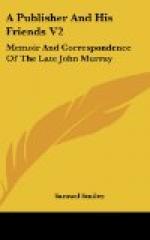In the meantime Mr. Murray made arrangements for the education of his son. He was first sent for a year to the High School of Edinburgh. While there he lived with Mr. Robert Kerr, author of several works on Chemistry and Natural History, published by Mr. Murray. Having passed a year in Edinburgh, the boy returned to London, and after a time was sent to a school at Margate. There he seems to have made some progress. To a friend Mr. Murray wrote: “He promises, I think, to write well, although his master complains a little of his indolence, which I am afraid he inherits from me. If he does not overcome it, it will overcome him.” In a later letter he said: “The school is not the best, but the people are kind to him, and his health leaves no alternative. He writes a good hand, is fond of figures, and is coming forward both in Latin and French. Yet he inherits a spice of indolence, and is a little impatient in his temper. His appearance—open, modest, and manly—is much in his favour. He is grown a good deal, and left us for Margate (after his holiday) as happy as could be expected.”
In the course of the following year Mr. Murray sent the boy to a well-known school at Gosport, kept by Dr. Burney, one of his old Mends. Burney was a native of the North of Ireland, and had originally been called MacBurney, but, like Murray, he dropped the Mac.
While at Dr. Burney’s school, young Murray had the misfortune to lose the sight of his right eye. The writing-master was holding his penknife awkwardly in his hand, point downwards, and while the boy, who was showing up an exercise, stooped to pick up the book which had fallen, the blade ran into his eye and entirely destroyed the sight. To a friend about to proceed to Gosport, Mr. Murray wrote: “Poor John has met with a sad accident, which you will be too soon acquainted with when you reach Gosport. His mother is yet ignorant of it, and I dare not tell her.”
Eventually the boy was brought to London for the purpose of ascertaining whether something might be done by an oculist for the restoration of his sight. But the cornea had been too deeply wounded; the fluid of the eye had escaped; nothing could be done for his relief, and he remained blind in that eye to the end of his life. [Footnote: Long afterwards Chantrey the sculptor, who had suffered a similar misfortune, exclaimed, “What! are you too a brother Cyclops?” but, as the narrator of the story used to add, Mr. Murray could see better with one eye than most people with two.] His father withdrew him from Dr. Burney’s school, and sent him in July 1793 to the Rev. Dr. Roberts, at Loughborough House, Kennington. In committing him to the schoolmaster’s charge, Mr. Murray sent the following introduction:
“Agreeable to my promise, I commit to you the charge of my son, and, as I mentioned to you in person, I agree to the terms of fifty guineas. The youth has been hitherto well spoken of by the gentleman he has been under. You will find him sensible and candid in the information you may want from him; and if you are kind enough to bestow pains upon him, the obligation on my part will be lasting. The branches to be learnt are these: Latin, French, Arithmetic, Mercantile Accounts, Elocution, History, Geography, Geometry, Astronomy, the Globes, Mathematics, Philosophy, Dancing, and Martial Exercise.”




